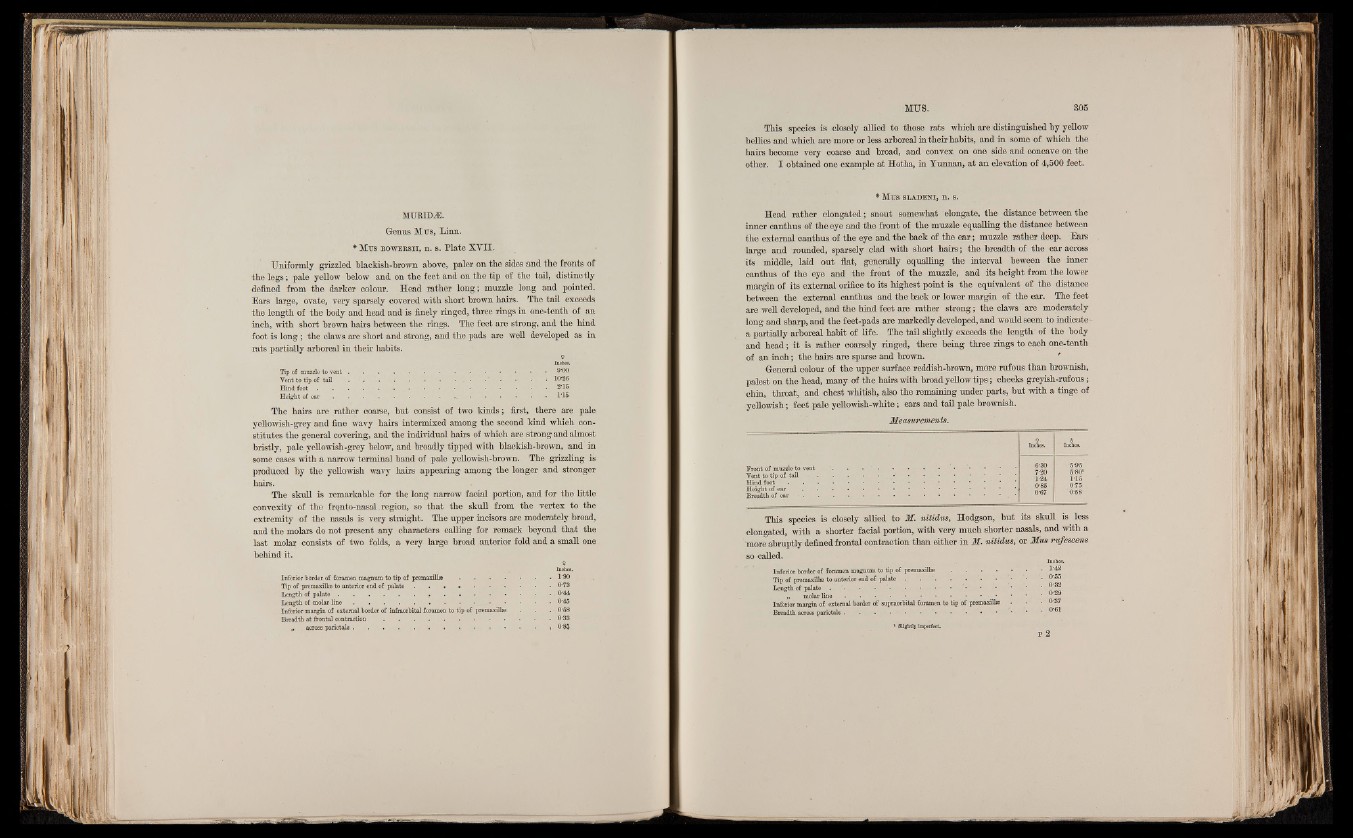
MURIDÆ.
Genus Mus, Linn.
* Mus b o w e r s i i , n. s. Plate XVII.
Uniformly grizzled blackish-brown above, paler on the sides and the fronts of
the legs; pale yellow below and on the feet and on the tip of the tail, distinctly
defined from the darker colour. Head rather long; muzzle long and pointed.
Ears large, ovate, very sparsely covered with short brown hairs. The tail exceeds
the length of the body and head and is finely ringed, three rings in one-tenth of an
inch, with short brown hairs between the rings. The feet are strong, and the hind
foot is long; the claws are short and strong, and the pads are well developed as in
rats partially arboreal in their habits.
9
Inches.
Tip of muzzle to vent ............................................................................................... 9'0Q
Vent to tip o f tail , . • . . ; . . . . . •- ■ > $ 10'26
Hind foot • 216
Height o f e a r .............................................................................. • • • > ' - 1'16
The hairs are rather coarse, but consist of two kinds; first, there are pale
yellowish-grey and fine wavy hairs intermixed among the second kind which constitutes
the general covering, and the individual hairs of which are strong and almost
bristly, pale yellowish-grey below, and broadly tipped with blackish-brown, and in
some cases with a narrow terminal band of pale yellowish-brown. The grizzling is
produced by the yellowish wavy hairs appearing among the longer and stronger
hairs.
The skull is remarkable for the long narrow facial portion, and for the little
convexity of the frQnto-nasal region, so that the skull from the vertex to the
extremity of the nasals is very straight. The upper incisors are moderately broad,
and the molars do not present any characters calling for remark beyond that the
last molar consists of two folds, a very large broad anterior fold and a small one
behind it,
?
inches:
Inferior border, of foramen magnum to tip of premaxilla 1‘90
Tip of premaxillæ to anterior end of palate • • • • • . • • • 0'73
Length of p a l a t e ....................................... . . • • • • • • •
Length o f molar line . . . . , . . • • • • • • • 0‘45
Inferior margin o f external border of infraorbital foramen to tip of premaxillæ . . . 0'58
Breadth at frontal contraction . . . . . . . . . . . . 0‘33
„ across parietals
This species is closely allied to those rats which are distinguished by yellow
bellies and which are more or less arboreal in their habits, and in some of which the
hairs become very coarse and broad, and convex on one side and concave on the
other. I obtained one example at Hotha, in Yunnan, at an elevation of 4,500 feet.
* Mus SLADENI, n. S.
Head rather elongated; snout somewhat elongate, the distance between the
inner canthus of the eye and the front of the muzzle equalling the distance between
the external canthus of the eye and the back of the ear; muzzle rather deep. Ears
large and rounded, sparsely clad with short hairs; the breadth of the ear across
its middle, laid out flat, generally equalling the interval beween the inner
canthus of the eye and the front of the muzzle, and its height from the lower
margin of its external orifice to its highest point is the equivalent of the distance
between the external canthus and the back or lower margin of the ear. The feet
are well developed, and the hind feet are rather strong; the claws are moderately
long aud sharp, and the feet-pads are markedly developed, and would seem to indicate -
a partially arboreal habit of life. The tail slightly exceeds the length of the body
and head; it is rather coarsely ringed, there being three rings to each one-tenth
of an inch; the hairs are sparse and brown.
General colour of the upper surface reddish-brown, more rufous than brownish,
palest on the head, many of the hairs with broad yellow tips; cheeks greyish-rufous;
chin, throat, and chest whitish, also the remaining under parts, but with a tinge of
yellowish; feet pale yellowish-white; ears and tail pale brownish.
Front of muzzle to vent
Vent to tip o f tail
Hind foot . .
Height of ear
Breadth of ear
This species is closely allied to M. nitidus, Hodgson, but its skull is less
elongated, with a shorter facial portion, with very much shorter nasals, and with a
more abruptly defined frontal contraction than either in M. nitidus, or Mus rufescens
so called. Inches.
Inferior border of foramen magnum to tip o f premaxilltB . . . • •
Tip o f premaxillse to anterior end of palate . . . . . ' • • ■ • •
Length of palate . • .......................................... .................................................................® ??
„ molar line . . . •. ’ • ■ • ’
Inferior margin of external border of supraorbital foramen to tip o f premaxill® . . • Ow
Breadth across parietals - • • • • • • 0 61
1 Slightly imperfect.
p 2